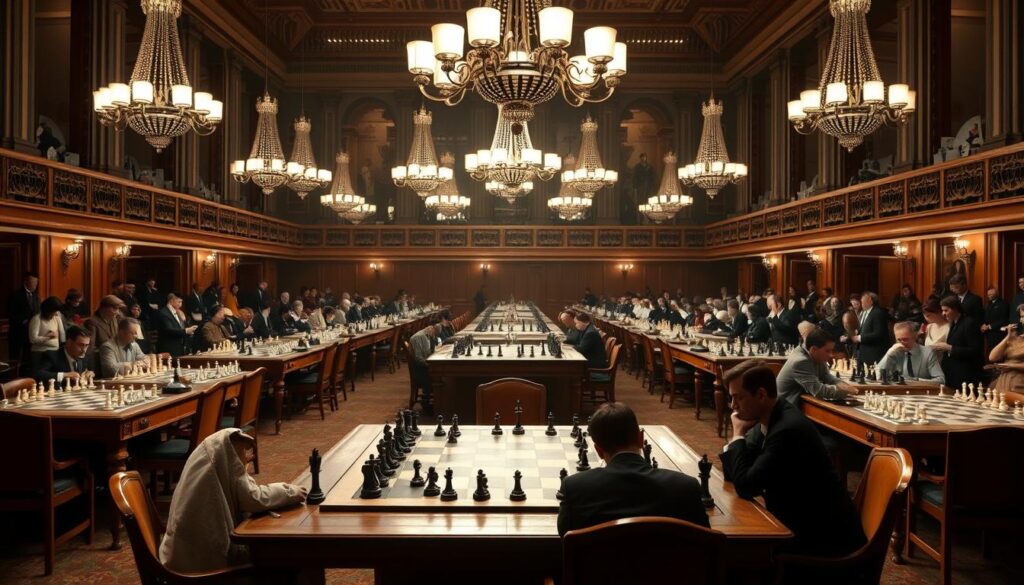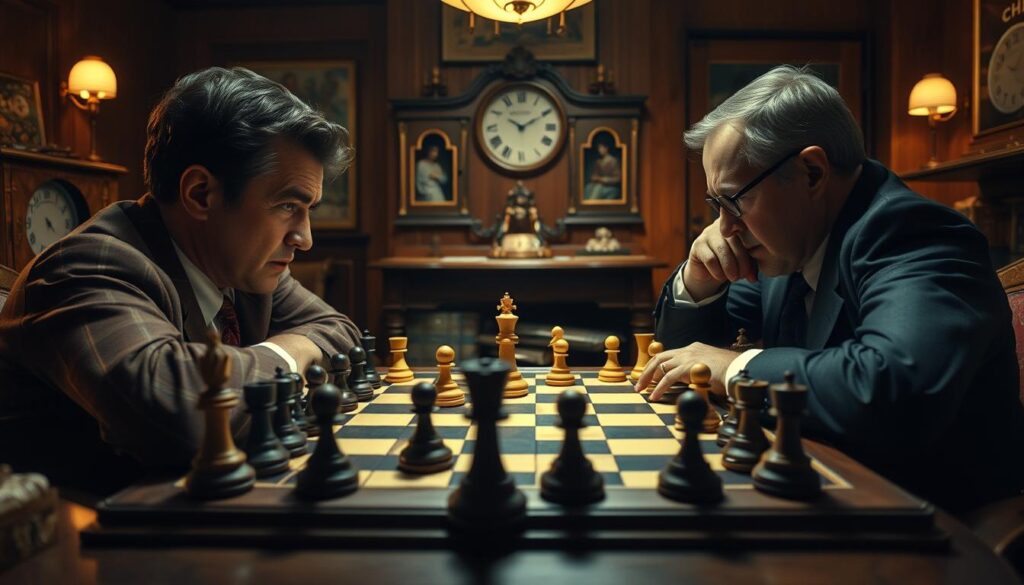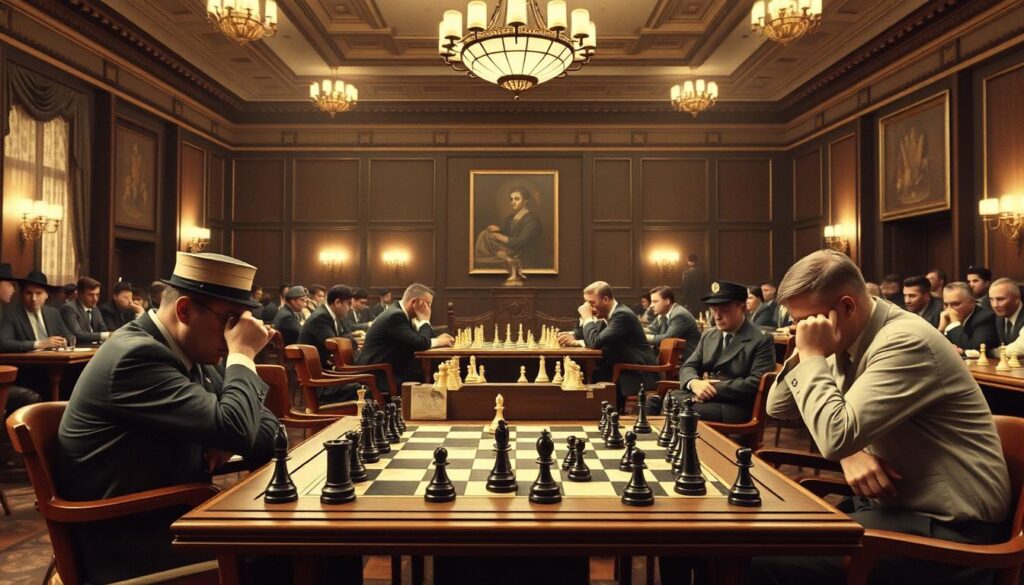Ever wondered what makes a chess tournament legendary? The 1953 US Chess Championship was a key moment in American chess. It was where strategic genius and young talent met on the board.
Young Bobby Fischer started to show his talent during this tournament. He caught the eye of chess fans all over the country. The 1953 US Chess Championship was more than a game; it changed the face of chess in the US.
Chess fans and historians see this tournament as a turning point. Players like Donald Byrne and new talents showed incredible skill. They set the stage for future chess innovations and strategies.
Table of Contents
The Historical Setting of American Chess in 1953
The year 1953 was a key moment in American chess history. The US Chess Federation, started in 1939, was growing its reach across the country. Chess was more than a game back then. It was a battle of wits, mirroring the Cold War’s global tensions.
Chess matches in 1953 were seen as tests of brain power. The 1953 championship was a time when national pride and strategy met on the chessboard. Players were not just fighting for themselves. They were showing off the US’s cultural and intellectual strengths.
- Chess became very popular in America after World War II.
- National tournaments were where players showed off their strategic skills.
- Chess competitions mirrored the intellectual battles of the Cold War.
The chess world was changing fast. International games and tournaments were getting more attention. Both amateur and pro players were part of a growing chess community. This community valued smart thinking and mental focus.
| Chess Trend | Impact in 1953 |
|---|---|
| National Interest | Rapidly Growing |
| Tournament Participation | Increasing |
| Public Perception | Intellectually Prestigious |
As the 1953 chess championship neared, fans were excited. They looked forward to seeing the top strategic minds in American chess. The tournament was set to be unforgettable, captivating a nation that loved intellectual challenges.
Key Players and Participants in the 1953 US Chess Championship
The 1953 United States Chess Championship was a big deal. It brought together top chess players. This event was a key moment in American chess history.
Samuel Reshevsky stood out as a top player. He showed his skill in the 1953 chess championship.
- Key participants included established grandmasters
- Rising young talents competed alongside veteran players
- Diverse skill levels represented in the championship
Many players with different skills and backgrounds took part. This showed the depth of chess talent in the US at that time.
| Player Category | Number of Participants |
|---|---|
| Grandmasters | 12 |
| International Masters | 18 |
| National Masters | 35 |
| Emerging Talents | 216 |
The 1953 US Chess Championship was more than a game. It celebrated chess skill and strategy. Players from all walks of life came to show their talent and competitive spirit.
Samuel Reshevsky’s Path to the Championship
In the 1953 US chess championship, Samuel Reshevsky stood out. Born in Poland, he moved to the United States as a child. His chess skills were unmatched by his peers.

Reshevsky prepared for the 1953 championship with great care. His early start in chess gave him a strong foundation. He focused on:
- Intense study of chess strategies
- Rigorous practice sessions
- Analysis of previous tournament performances
- Mental conditioning and focus
The 1953 championship was a key moment for Reshevsky. He combined technical skill with mental toughness. His deep chess knowledge and ability to predict moves made him a top contender.
Reshevsky showed great adaptability and strategic thinking during the tournament. His past successes in national and international competitions prepared him for the 1953 championship. This made him a strong candidate for the title.
Reshevsky’s victory was not just about winning games. It was about consistent performance, strategic planning, and a deep love for chess. His journey in the 1953 championship solidified his place as a chess legend.
Tournament Format and Organization
The 1953 US Chess Championship was a key moment in American chess. The US Chess Federation organized it with great care. The tournament used a round-robin format to test players’ skills and mental strength.

The tournament’s design aimed for a fair competition. Important parts included:
- Round-robin format where every player competed against every other participant
- Multiple game rounds spread across several weeks
- Strict adherence to official chess regulations
- Neutral venue to guarantee fair play
Players in the 1953 US Chess Championship had to show great skill and mental toughness. The round-robin format meant each player faced every other, making it a tough test of chess skills.
| Tournament Aspect | Details |
|---|---|
| Competition Type | Round-Robin |
| Number of Participants | Top National Players |
| Duration | Several Weeks |
| Organizing Body | US Chess Federation |
This approach to the 1953 US Chess Championship showed how competitive chess was growing in the US. Each game was a chance for players to show their strategic thinking and competitive spirit.
Decisive Games and Critical Moments
The 1953 US chess championship was a key moment in American chess history. It showed incredible tactical skill and deep strategy. Players fought hard, creating games that chess fans and experts still study today.

Many games from the 1953 championship were known for their complexity and dramatic turns. This tournament showed the high chess skill in the US at that time.
- Spectacular tactical combinations challenged traditional chess strategies
- Critical matches between top contenders captured significant attention
- Unexpected strategic maneuvers revealed players’ exceptional skills
The most exciting moments in the 1953 US chess championship came from deep positional play and sharp calculation. Players moved through complex board positions with great precision. They pushed the limits of chess theory.
| Player | Notable Game Characteristic | Strategic Significance |
|---|---|---|
| Samuel Reshevsky | Aggressive Attacking Style | Demonstrated exceptional tactical creativity |
| Arthur Bisguier | Strategic Positional Play | Highlighted deep strategic understanding |
| Herman Steiner | Dynamic Piece Coordination | Revealed advanced chess technique |
Every game in the 1953 US chess championship added to the tournament’s rich story. It showed the depth of strategic thinking and competitive spirit among American chess masters.
1953 US Chess Championship: Round-by-Round Analysis

The 1953 United States Chess Championship was a key moment in American chess. Each round showed strategic battles and chess mastery. This defined a generation of competitive play.
Players went through intense rounds with careful planning. The 1953 chess championship showed amazing tactical skills and mental strength from top players.
- First rounds established early momentum for key contenders
- Middle rounds revealed critical strategic shifts
- Final rounds determined championship trajectory
Samuel Reshevsky stood out as a dominant force. His careful approach and deep strategy made him unique. Arthur Bisguier and Herman Steiner also posed big challenges.
Key strategic elements were seen in each round:
- Opening preparation became crucial
- Psychological resilience determined outcomes
- Technical precision separated top performers
The tournament’s progression showed the high skill level of American chess players. Each move was a complex calculation. This made the 1953 United States Chess Championship a deep intellectual battle.
Impact on American Chess Development
The 1953 US chess championship changed the chess scene in America. It made people all over the country interested in competitive chess. This sparked a new wave of strategic thinkers and passionate players.
Here are some key changes that came from this championship:
- More people saw chess as a serious intellectual activity
- Chess clubs grew in number all over the country
- Young chess fans got better training programs
- Chess events got more media attention
The tournament did more than just spark competition. It also led to deeper chess analysis and strategy. Players and fans studied the 1953 games intensely. They looked at key moves and developed new strategies.
| Area of Impact | Specific Contribution |
|---|---|
| Chess Education | Started more structured training programs |
| Tournament Organization | Boosted national chess competition standards |
| Player Development | Helped emerging talents find clear paths |
The 1953 US chess championship turned chess into a respected sport. It showed how strategic thinking and competition can change a culture. The tournament’s influence still inspires chess players today.
Media Coverage and Public Reception
The 1953 US Chess Championship grabbed the American public’s attention like never before. Newspapers all over the country gave it lots of space. This brought chess into homes and sparked a big interest in the sport.
People’s excitement for the 1953 US Chess Championship was at an all-time high. Fans watched matches with great dedication. This turned chess into a big cultural event.
- Extensive radio broadcasts brought live tournament updates to listeners
- Major newspapers provided daily game analyses
- Local chess clubs organized public viewing events
- Spectators packed venues to watch matches in person
Media showed how smart the players were, making them stars. The tournament proved chess was more than a game. It was a complex mental challenge that needed strategic thinking.
| Media Outlet | Coverage Type | Audience Reach |
|---|---|---|
| New York Times | Detailed Match Reports | National |
| Radio Networks | Live Tournament Updates | Nationwide |
| Local Newspapers | Regional Game Summaries | Regional |
The 1953 US Chess Championship changed how Americans saw competitive chess. What was once seen as a rare intellectual activity became a celebrated event. It inspired a new wave of chess fans and players.
Championship’s Influence on International Chess
The 1953 US Chess Championship was a turning point for international chess. It highlighted the skill of American players. It also made the United States a major force in global chess.
Strategies from the 1953 championship caught the eye of grandmasters everywhere. They studied the games closely. They saw the deep strategies and new ideas from American players.
- Elevated US chess reputation on the global stage
- Introduced novel tactical approaches to international chess theory
- Sparked increased international interest in American chess players
The tournament did more than just show who was the best. It made the world see the United States as a chess power. This changed how people saw American players before.
| International Chess Impact | Key Developments |
|---|---|
| Global Strategy Analysis | Comprehensive game studies by international experts |
| Tournament Reputation | Increased credibility for US chess championships |
| Player Recognition | Enhanced international profiles for American participants |
The 1953 championship showed that American players could compete with the best. It changed how the world saw chess. It inspired many to follow in their footsteps.
Conclusion
The 1953 United States Chess Championship was a key moment in American chess history. It showed off incredible skill and deep chess strategies. This tournament marked a big step forward for competitive chess in the U.S.
This event is a big deal for future chess players. It raised the bar for competition and inspired many to strive for greatness. Samuel Reshevsky’s play and the games from that time still excite chess fans and historians today.
The 1953 Championship shows the high level of chess in America. It was more than a game; it was a cultural event that made chess respected. Its impact still shapes chess in the U.S. today.
Thinking about this event, remember it’s not just about winning. It’s about exploring new strategies and pushing human limits. The 1953 Championship is a key part of American chess history.
FAQ
What was the significance of the 1953 US Chess Championship?
The 1953 US Chess Championship was a key event in American chess history. It showed the competitive spirit and strategic skills of top players during the Cold War. It brought together notable chess talents and played a crucial role in promoting chess in the United States.
Who were the key players in the 1953 US Chess Championship?
Samuel Reshevsky was a dominant force in the championship. The tournament featured a mix of experienced grandmasters and promising young talents. This represented the depth of chess skill in America during that period.
What was the tournament format?
The championship followed a round-robin format. Each participant played against every other player. It was organized by the US Chess Federation and took place over several weeks in a prestigious venue.
How did the 1953 championship impact American chess?
The tournament inspired a new generation of players. It increased public interest in chess and led to improvements in chess organization and promotion across the country. It also contributed significantly to the growth of chess literature and analysis.
How was the championship received by the media?
The 1953 US Chess Championship received considerable media attention. Newspapers and radio broadcasts covered the event. This helped bring chess to a wider audience and elevated its status as a respected intellectual pursuit.
What was the international significance of the 1953 championship?
The tournament showcased the strength of American players on the global stage. It influenced chess strategy and theory beyond US borders. It strengthened America’s position in international chess competitions and negotiations.
Who was Samuel Reshevsky?
Samuel Reshevsky was a chess prodigy born in Poland. He moved to the United States as a child. He became a prominent grandmaster and was a dominant force in American chess during the 1953 championship.
What was the context of chess in America during 1953?
In 1953, chess was gaining popularity and recognition in the United States. The US Chess Federation, established in 1939, was promoting the game nationwide. The Cold War era viewed chess competitions as intellectual battles between nations.




